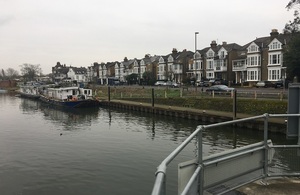Boats put River Thames traffic at risk
Double barge-owner convicted for illegal moorings.

Trotman's boats hampered other vessels making their way through Molesey Lock on the River Thames
The owner of a pair of 25-metre houseboats obstructing a busy part of the River Thames in Surrey has been convicted of breaking river laws.
Alistair Trotman, of Kingston upon Thames, ignored warnings from the Environment Agency he was flouting bylaws designed to keep the river safe and clear. He broke limits on the time a boat can be moored in one place at or near a lock.
The 55-year-old, who rented out Kupe and Rhythm of River as permanent and temporary accommodation, left the former commercial barges end-to-end in an Environment Agency lay-by at Molesey, among the busiest locks on the Thames, between October 2018 and the following March.
Even a formal direction to move, issued by the Thames harbour master, had no effect. This led the Environment Agency, which owns the riverbank at Molesey Lock, to take Trotman to court for, in effect, compromising the safe passage of other boats through the lock.
Sitting at Staines magistrates’ court, district judge Susan Cooper was told Trotman’s inconsiderate actions exposed other boats and their crews to obstruction and possible danger.
Colin Chiverton, environment manager for the River Thames at the Environment Agency, said:
Trotman showed contempt for the rules. He not only moored both boats in the same place for several months, but then snubbed formal harbour master notices to move. The majority of boats using Environment Agency locks do so lawfully and continue along the river.
The Environment Agency also maintains some limited short-stay public moorings along almost 150 miles of the non-tidal River Thames to encourage pleasure boating and enable secure berthing at set locations.
We strongly advise all boat-owners on the Thames to give serious consideration to the size and type of vessel they use and how to comply with landowner mooring requirements.
Boats moored permanently to land on the non-tidal River Thames need the consent of the landowner – and mustn’t cause an obstruction to other traffic.
Trotman did move Rhythm of River a few metres from its original position after being warned legal action was a possibility, but he was still in breach of the harbour master notices issued against both boats.
When Trotman refused the agency’s instructions to move the boats in March 2019, waterways officers were forced to tow them to an Environment Agency mooring on a wider part of the Thames. Kupe was moved with the owner still inside. Trotman refused to come out to talk to officials, who had tried to contact him through documents posted on the vessels, phone calls and letters. Trotman took no notice.
As on the road, those with powered or unpowered boats on the river need to make sure they don’t cause an obstruction to other traffic, or interfere with land adjacent to the river. The Environment Agency maintains more than 600 miles of inland waterways across England, keeping them open and safe for thousands of river-lovers.
On 7 October 2021, Staines magistrates’ court convicted Trotman, of Castle Street, Kingston upon Thames, of causing or allowing Kupe and Rhythm of River to remain in a lock, channel or cut for longer than necessary.
The same court also found Trotman guilty of twice failing to comply with a harbour master notice to move the boats when directed. The offences were in breach of the Thames Navigation Licensing and General Byelaws 1993 and the Thames Conservancy Act 1932.
Trotman, who represented himself, consistently denied he was in the wrong. He will be sentenced on 19 January 2022.
Updates to this page
Published 11 October 2021Last updated 13 December 2021 + show all updates
-
The date of sentencing in this case has been changed to 19 January 2022.
-
First published.